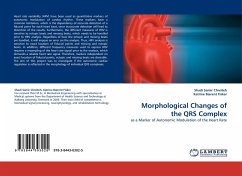High Quality Content by WIKIPEDIA articles! The QRS complex is a name for some of the deflections seen on a typical electrocardiogram (ECG). It is usually the central and most visually obvious part of the tracing. It corresponds to the depolarization of the right and left ventricles. Classically the ECG tracing has 5 deflections, arbitrarily named P to T waves (in some conditions there is a U wave as well). The Q, R and S wave occur in rapid succession, do not all appear in all leads and reflect a single event so are thus normally considered as a whole complex. A Q wave is any downward deflection after the P-wave. An R-wave is an upward deflection and the S wave is any downward deflection after the R-wave. The His/Purkinje specialized muscle cells coordinate the depolarization of both ventricles and if they are working efficiently the QRS complex is 80 to 120 ms in duration (represented by three small squares or less at the standard paper speed of 25mm/s). Any abnormality of conduction takes longer and causes "widened" QRS complexes.








